What is Spread Footing?
Spread footings are commonly utilized to support each column of a building and the piers of a bridge. Construction of these footings is both cost-effective and economical. It works well in any soil with sufficient load-bearing capacity. Spread footing comes in various forms and sizes, including square, round, and rectangular. With stresses applied upward, this footing can operate as an inverted cantilever.
For the construction of spread footings, structural design codes and specifications assume a linear soil pressure distribution. As a result, designing spread footing is a lot easier.
Spread Footing Foundation:
Residential constructions frequently use spread footing foundations. This foundation “spreads” the structure’s weight across a larger area to spread the load coming through the load-bearing over a larger area and increase the building’s stability. Due to some unfavorable conditions, the design and layout of spread footings are regulated. Some situations may exist, such as soft soil beneath the building or a change in soil volume due to frost penetration.
Types of Spread Footing Foundation:
A spread foundation is built to support each column individually in the case of bridges. Following are some of the types of the spread footing foundation.:
1. Wall Spread Footing:
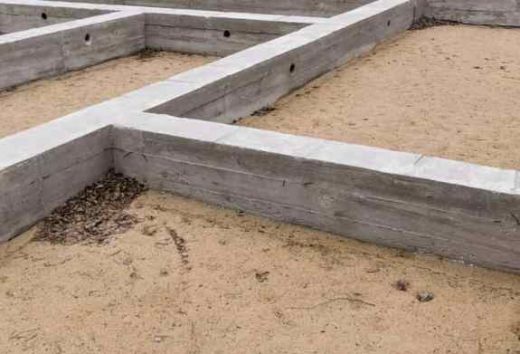
Fig 1: Wall Spread Footing
Courtesy: civiconcept.com
Strip footing is another term for wall footing. The load is transferred from the building to a vast land area by a continuous strip of concrete in this footing style. This footing is made by increasing the thickness of plain concrete or reinforced concrete, depending on the load-bearing wall. Using stone, brick, plain concrete, or reinforced concrete to make a wall footing.
Pad spreads and strip footings are the most common wall footings used in homes. It provides a strong foundation for structural and non-structural walls by conveying loads to the structure.
2. Combined Footing:
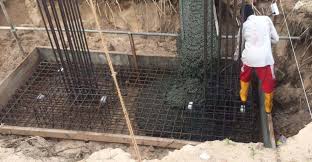
Fig 2: Combined Footing
Courtesy: structuralguide.com
A combined footing is used when two or more columns in a straight line are borne on a single spread footing. The most cost-effective option is to use isolated footings for each column. Combined footings are only used when essential, such as building a house.
Its construction is done so that the center of gravity of the footing area is equal to the center of gravity of the two columns or more column footing is supported, based on the above purpose.
The combined footing is usually reinforced concrete because it is expected to be inflexible and rest on uniform soil. Individual footings and soil with limited load-bearing capability necessitated additional area, which was excellent conditions for the building’s combined footing.
There are two different types of combined footing:
i)Rectangular-shaped combined footing: The columns are all similar.
ii) Trapezoidal-shaped combined footing: Columns aren’t all equal, and there’s a limit to how much area they can take up.
3. Isolated Spread Footing or Column Spread Footing:
The solitary or individual footing that transfers the load to the subterranean earth is isolated. It is used when only a single column is required. The substructure component that makes direct touch with or is resting inside the earth is known as the foundation.
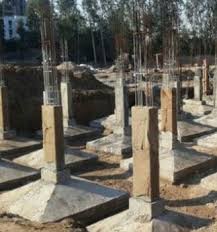
Fig 3: Isolated Spread Footing
Courtesy: theconstructor.org
Isolated footings are cost-effective, simple to install, require minimal excavation, and are simple to construct. When there is a large distance between columns, an isolated footing is one of the most commonly utilized foundations in the building business. It is used when the soil’s geotechnical qualities do not change significantly in the foundation area. It is also the most financially advantageous type of foundation.
An isolated footing can be further divided into three types:
i) Stepped Footing
ii) Sloped footing
iii) Simple Spread Footing
4. Continuous Spread Footing:
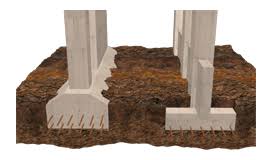
Fig 4: Continuous Spread Footing
Courtesy: finesoftware.eu
This form of footing can support more than two columns. The load from each column is transferred directly to the footing in this sort of footing. Continuous footing is when a longitudinal beam connects the column’s footings.
In earthquake-prone areas, the continuous footing is commonly used. During a natural disaster, this style of footing can be a compromise against mobility. Its purpose is to keep the constitutional movement from jeopardizing and maintaining stability.
5. Strap Footing:
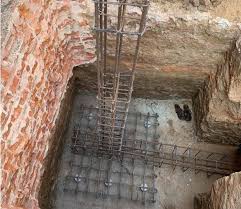
Fig 5: Strap Footing
Courtesy: expertcivil.com
The cantilever or strap footing connects an eccentrically laden column to the column’s interior. In contrast, the strap transmits the moment induced by the eccentricity to the interior columnar foot, resulting in consistent soil pressure under both footings.
Suppose the distance between the columns is large or the permitted soil pressure is high. In that case, strap footing could be utilized instead of rectangular or trapezoidal joint footing in situations where extra footing space is not required.
6. Grillage Footing:
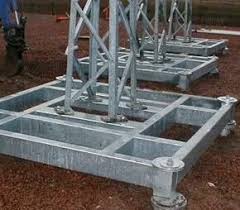
Fig 6: Grillage Footing
Courtesy: civilclick.com
Grillage Footing is a shallow foundation of one, two, or more tiers of beams superimposed over a layer of concrete to distribute the load over a larger area of damp or loose soil beneath. It’s ideal for piers, scaffolds, and large construction columns. The grillage foundation is also appropriate when a structure’s foundation is a shallow foundation constructed over moist or loose soil. Grillage foundations can support and transfer significant loads from a structure to broad areas.
7. Inverted Arch Footing:
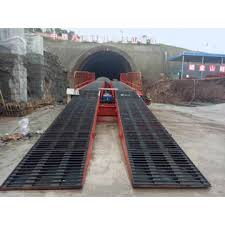
Fig 7: Inverted Arch Footing
Courtesy: lijianformwork.com
Inverted Arch Footing was once utilized as a foundation for multistory structures. This foundation form is employed when the soil’s carrying capacity is low, and the structure’s weight is carried to the footing via the walls. Where there is a concern, deep excavation can also be done.
The inverted arch footing is only used in extremely few circumstances nowadays because of robust construction methods such as reinforced cement concrete developments. In soft soil, the inverted arch footing is a good way to compromise foundation depth.
8. Raft Foundation:
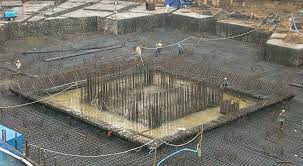
Fig 8: Raft Foundation
Courtesy: constructionheadline.com
Raft foundations are made out of a thick reinforced concrete slab that spans a vast amount of soil and supports multiple columns and load-bearing walls. It’s also known as a mat foundation, and it’s a popular foundation system. A shallow foundation is known as a raft foundation.
A raft foundation can be used instead of trench fills or strip foundations. Engineers recommend raft foundation if trench fill and strip foundation is difficult to build.
Design of Spread Footing:
- The first stage is to determine the load on the foundation of the building from various components of the structure.
- Geographical and technical information about the construction site is gathered. And the proposed data is interpreted to obtain soil quality information.
- The depth and location of the various elements for the foundation of the building be decided.
- The next stage is establishing the soil’s carrying capacity at the foundation’s proposed location.
- Compromises are reached for both complete and differential land settlements. This settlement’s impact on the foundation is taken into account.
- A suitable grade of concrete is chosen to determine concrete strength.
- The steel grade has been chosen.
- Determine the dimensions of the required footing.
- Calculate the foundation. T or D in thickness.
- The bar’s size and the spacing must all be determined before the footing can be reinforced.
- The relationship between the superstructure and the foundation should be designed.
- The structure-soil system is checked for uplift and stability against sliding and overturning in the final step of the operation.
Area of Spread Footing :
Spread footing area can be calculated by using the formula:
A=Qt/q
Qt- Total load on spread footing
q- The area of spread footing.
Advantages of Spread Footing:
- This type of foundation can be produced in various shapes, including rectangles, squares, and rounds, depending on the application.
- .Spread footing can be constructed quickly and easily.
- Spread footing construction is cost-effective in terms of labor
- Spread footing necessitates the use of less trained personnel. It can be built with low-skilled labor.
- In soil with low load-bearing capability, spread footing allows the building load to be distributed over a large area.
- Materials for spread footing are readily available in the area.
- Damage from natural calamities such as frost can be reduced.
- Spread footing is less prone to having a differential settlement.
- Because spread footing is built in a simple and vast region, the probability of structural collapse is quite low.
- Spread footing has a substantially lower failure rate than other types of footing.
- Spread footing transfers and distributes the weight over a vast soil area to provide more stability to the building’s structure.
- In the construction of residential houses, spread footing is commonly used.
Disadvantages of Spread Footing:
- Spread footing is only suitable for certain soil structures and cannot be utilized on all soil types.
- Settlement is a significant issue with this sort of foundation.
- Torsion, moment, and pullout are all constants in this foundation form.
- Once the spread footing kind of foundation is created, irregular ground surfaces render the building sloppy.
Conclusion:
Spread footing is a form of foundation designed and built to hold up superstructure elements like steel or concrete columns, walls, and so on. It is the most general construction used to keep a structure from sinking into the earth. Compared to other foundations, it has a lower construction cost and more simple quality assurance and quality control method.
References:
1. Ramiz, E. (2020, May 20). Spread Footing | Equation, 4 Types & Benefits. Civil Click; www.civilclick.com. https://www.civilclick.com/spread-footing/
2. What Is Spread Footing? | Types of Spread Footing Foundation | Design of Spread Footing. (2021, July 25). 9To5Civil; 9to5civil.com. https://9to5civil.com/spread-footing/
3. What is Spread Foundation and Spread Foundation types. (2019, October 13). Civil Knowledges; www.civilknowledges.com. https://www.civilknowledges.com/spread-foundation/
4. Rajput, K. (2022, February 27). What Is Spread Footing | 8 Types of Spread Foundation | Concrete of Spread Footing | Spread Footing Design | Advantages & Disadvantages of Spread Footing. CivilJungle; civiljungle.com. https://civiljungle.com/spread-footing/
5. Chhapola, K. (2022, February 7). What is Spread Footing Foundation | Types of Spread Footing. CivilChapola; civilchapola.com. https://civilchapola.com/spread-footing/
6. Mahajan, B. (2021, July 6). Spread Footing | Spread Footing Design | 8 Types of Spread Foundation | Spread Foundation | Advantages & Disadvantages of Spread Footing. Civiconcepts; civiconcepts.com. https://civiconcepts.com/blog/spread-footing
7. Prasad. (2022, February 25). Spread Footing Types, Design and Construction – Structural Guide. Structural Guide; www.structuralguide.com. https://www.structuralguide.com/spread-footing/
If you have a query, you can ask a question here.


